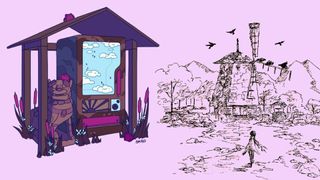I'm a simp for a good city builder, just as I am for a tasty TTRPG. Put me in front of Cities: Skylines or Urbek City Builder and I'll construct you a utopia. Challenge me to create a fascinating character for your tabletop roleplaying game, and you can bet I'll come up with a backstory even the most advanced LLMs couldn't dream of, pet electric sheep and all.
A little while back, I discovered I could combine these two creative hobbies in the form of collaborative, city building tabletop games. And having recently been introduced to my newest worldbuilding obsession—'I’m sorry did you say street magic (opens in new tab)', by Caro Asercion—I thought it was about time I brought the wonders of tabletop city building to the general public.
It all started a few years back when I was introduced to The Quiet Year (opens in new tab), a tabletop colony/city builder by Avery Alder. The game sees you and a group of friends steward a budding society, masquerading as its members while they try to recover before the coming of the 'Frost Giants'—the nature of this adversary evolves as you play, and is never specified in the rules.
During gameplay, you're asked to draw out new features as they are invented, erected, or discovered, and depict the events that unfold on a map. Each turn, players choose between two options for every random prompt in the game's season charts, which you work through with a standard pack of playing cards. It's a bit different to, say, the dice you would use for a random roll table in D&D, and it means you never run into the same event twice.

As you're playing essentially GMless, maybe with someone vaguely guiding the process, everyone gets a chance to create. With every passing month the stakes increase as the severity of events increases, and your people hurtle ever closer to their imminent demise. Or you decide that, together, you've prepared your little city (town, colony, whatever) for the challenges of the coming apocalypse.
The stories that come out of this simple framework are often so enchanting, it's really astounding to me how collaborating to create a society with friends can be so fulfilling.
One playthrough in particular will stay with me forever. Myself and my good friend, Twitch streamer DaizeeJones (opens in new tab), designed a civilisation together with our partners. A Lilliputian village hanging by a thread, situated on the trunk of a great tree. Unaware of the world beyond, they toiled away and one day panic ensued as they woke to their roads and homes showered in an unidentifiable red substance.
As a collective, we pulled back the imagined cameras from the reddened bark and panned over to a humongous articulated truck in the middle of a misty forest. Slapped across the side of the truck: a logo that read "Frost Giants Forestry Co." And there, we had our antihero.

In a similar vein, 'I’m sorry did you say street magic' gives you the keys to an emergent city, where heroes and villains arise as you populate it. Together you come up with three adjectives to describe the kind of city you want to build, to set the overall tone of your development.
Be it ethereal, narrow, sleepy, wayward, vast, or frigid, your city comes to life through your words, and the "true names" each new place or person is given. Just like The Quiet Year, this game focuses on the evolution of your society and the stories that take place within it, though there's a bit more freedom to generate ideas without the restrictions of specific prompts.
After the foundations are laid, each round sees a Compass declared, in order to lead the designs that ensue. It's essentially a focus around something or someone, even a more broad theme or concept to keep everything flowing in the same direction for that round.

Then each player is asked to "wander the city", choosing to design strange neighbourhoods, landmarks, or residents. You tie them all together as the game progresses, and there are chances to act out the "voices of the city", holding debates and wading headfirst into the lives of your city-goers.
Both games' exceptional creative freedom means I always feel deeply connected to the things my friends and I create. And while I do feel connected to my digital cities, there's something deeply tribal about gathering around a table to pitch fantastical inventions, tell intricate tales, and stir political turmoil.
It also helps get the creative juices going when these games are beautifully illustrated, 'I’m sorry did you say street magic' with the art of Shannon Kao (opens in new tab), and Ariel Norris (opens in new tab)' illustrations for The Quiet Year.
You can get the physical version of Alder's The Quiet Year for $48.53 / £39.22 in the Buried Without Ceremony store (opens in new tab), or the PDF version for $7.47 / £6.03. 'I'm sorry did you say street magic' comes in at $15 for the PDF (opens in new tab), though there's a small pool of community copies available for those who can't afford to pay the full price. Asercion only asks that you leave a nice review as thanks.

